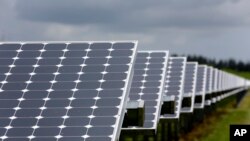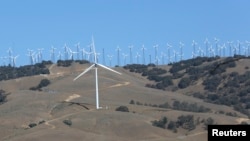Near wheat fields in rural Kansas, wind turbines spin away, producing clean energy that doesn’t contribute to climate change. But they do contribute to the local economy. Smiling at the turbines on his farm, Ted Bannister says, “Now on a windy day, I’m willing to buy lunch for somebody, because that’s money in my pocket.”
Midwestern wind is so abundant, in theory, it could even light up east coast cities. Unfortunately, most Kansas wind power never gets that far. Just as it’s impossible to drive fast in a traffic jam, today’s regionally-focused transmission lines make it impossible to send energy across the nation.
“[Transmission lines] are not like highways because the on-ramps and off-ramps are so incredibly expensive," Bannister explained. "State, federal, county and then certainly on the business side of it there, they’ve been much more competitive than cooperative.”
And there’s another problem. Even in windswept Kansas, the wind doesn’t always blow. In sunny Arizona, the sun doesn’t always shine. To power the grid during those times, utility companies depend on fossil fuels, an expensive, but vital, redundancy.
Renewable energy nation
Meteorologist Alexander MacDonald remembers the day he realized it didn't have to be that way. He was having a conversation with some colleagues about the cost of renewable energy, at a climate change conference six years ago.
“This guy over a beer says, 'No one’s going to do anything. Nobody’s going to accept a doubling of cost.' I said, 'Wait a minute, wind and solar energy are really cheap. It should work.'” He recalls thinking that the U.S. is so big geographically, the wind is always blowing somewhere. And tapping all that wind potential all at once might reduce the need to maintain expensive backup fossil fuels.
MacDonald says all this was on his mind when he returned to the National Oceanic and Atmospheric Administration in Boulder, where he directed the Earth System Research Lab. “I came back hellbent to prove the wind and solar do work if you get the right scale corresponding to the weather.”
After six years of rigorous computations, MacDonald’s team has determined that by using existing technologies, carbon-free wind and solar power can power the entire U.S., at a lower cost than fossil fuels. What’s needed to balance the ups and downs of local weather, MacDonald says, is a unified plan across a very large geographic area.
Electron superhighway
With a national plan for more wind turbines and solar panels, MacDonald says that even on calm, cloudy days, the U.S. could harvest almost all its energy from a few big pockets of wind and sun. He foresees that energy being sent instantly from where it's generated to where it's needed, over a nationwide grid of High Voltage, Direct Current Transmission Lines that he compares to the interstate highway system.
MacDonald, who recently retired from NOAA, says this electron superhighway could eliminate the need for regional backup from fossil fuels, and reduce U.S. carbon emissions by 80 percent by the year 2030, for less money than by sticking with mostly fossil fuels.
At the Center for Strategic and International Studies, energy analyst Sara Ladislaw says the plan has merits, giving it "a thumbs up" in terms of technological feasibility. But she warns that “business as usual” in the power industry will block the plan from happening by 2030. “If you think about it from a regulatory and a market resolution standpoint, I just think there’s a lot of things that would have to get resolved.” Including local opposition to the 82-foot tall high voltage towers that would support that transmission grid.
Power underground
But Christopher Clack, a physicist at the Cooperative Institute for Research in Environmental Sciences and leader of site optimization on MacDonald's team, says the transmission lines don’t have to go overhead. “A five gigawatt wire is about this sort of big," he pointed out, holding his hands apart the width of a dinner plate, "and you could bury them underground, and you only have to go down a few meters.”
Clack says the nation’s railroad right-of-ways are the perfect location to bury the high voltage DC transmission grid. Although that would cost more than putting the lines overhead, it would be far less expensive than staying with fossil fuels. And as better battery storage, wind turbines and solar panels come on line, Clack says costs will come down even further. The key, he says, is to eliminate the need for major backup from fossil fuels. And that means focusing on the nation, not individual states.
"If you want to do it cheaply, go as big as you can. If you want to pay more money, go small.”
He and MacDonald say that if policy makers join them in thinking big, in less than 15 years, the U.S. could become a renewable energy nation.













